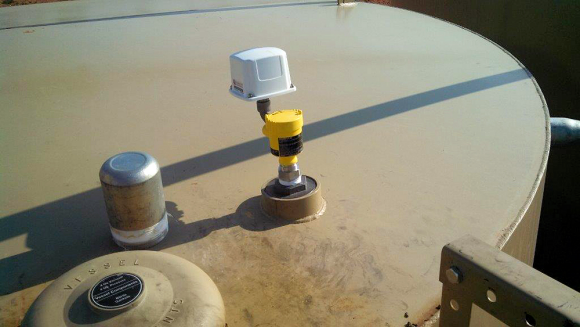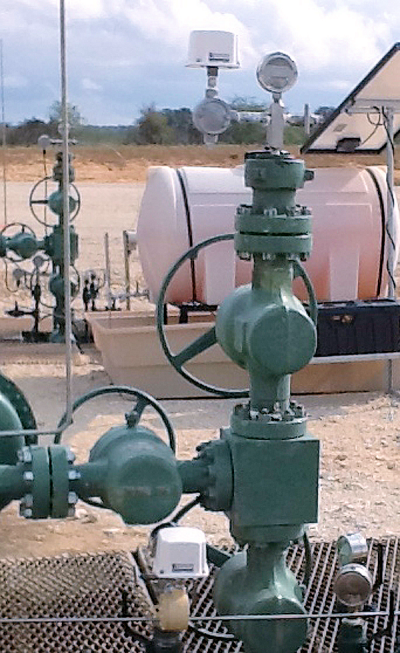
The Current State
Since Edwin Drake drilled the first oil well in Pennsylvania, oilfields have operated on data. The reason is simple: economics. After all, each oil or gas well is attached to a cash register. Various interested parties, from the land owner and mineral rights owner to the production company and taxman, are all paid based on well production. Costs are also assigned to each well and various interests.
Until recently, oilfield operating parameters were typically monitored manually on a daily (at best) basis. A worker, called a pumper, would travel from well to well on a daily route, writing down information for each well on metrics such as tank levels, flow, and pressures as well as making needed repairs and upgrades. Picture a skilled worker, driving a $50,000 pickup truck with $25,000 worth of tools and parts, bouncing along bad roads, servicing 20 to 30 wells a day. Even today, this scenario remains quite common.
Going Forward
Yet over the last 20 years, a quiet technological revolution has taken place in the oilfield. First, as oil and gas prices rose, the economic incentives to maximize production led to innovations in monitoring. As the old saying goes, "Production that is lost can never be made up." The key motivation at this time was to detect a failure in a well's operation so it could be corrected as quickly as possible to maintain production.
More recently, as oil and gas prices have fallen, a focus on reducing total operating costs has driven the use of remote monitoring and control as a substitute for labor. Layered on the drive for greater productivity is the need to reduce the risk of spills and other environmental damage.
Next page
Limits Of Wired Systems
Traditionally, almost all monitoring and control activities consisted of wired systems that connected sensors and actuators to some form of local control device - a flow computer, RTU or SCADA device. While wired systems have been around for a long time, some of the unique attributes of oil and gas operations have proved challenging for traditional wiring. Specifically:
-
Communications distance can be large. The distance between monitored assets can range from a modest 20 to 50 yards to a daunting 1,000-plus yards.
-
Travel time for installers can be significant. It is not unusual for an electrician to have to travel two or more hours to reach a work site and for an installation to take several days at best to weeks at worst.
-
The local environment can present difficulties. Conduit may have to be buried, while wells are regularly subjected to "workovers," during which the well and its associated sensors and wiring are torn apart to.
-
Some wires just can't be run on property not owned by the production company, such as roads, cemeteries, streams, or other structures.
- Wired solutions can be expensive to implement and maintain. Installed costs can run $5 to $20 per foot, or more if trenching is required. These installation costs can discourage the use of wire even if the measurement is a desirable one to make.
Advent Of Wireless Monitoring And Control
Wireless sensor networks can help oilfield operators overcome the limitations of wired systems. However, to be truly effective, wireless systems must have adequate range in addition to being wireless in the correct sense, i.e., involving low enough power that no power lines need be run.
Such systems also must be able to deliver monitoring and control functionality effectively in a hostile and dangerous environment. They have to operate unattended for years in the Texas sun and Alberta winters, in snow, rain, dust storms, and ice. And they need to be designed to operate safely in caustic and explosive environments.
Operators have tried off-the-shelf solutions but have had little success with them. A few vendors have developed wireless sensor networks that help operators surmount these challenges, and such systems have now been adopted in a variety of field applications.
Next page
How Wireless Works
Most well fields or well pads have a central data access point, which is connected to a local control device such as a flow computer, SCADA system, or RTU to retrieve the data from the oilfield for the operator's data repository. Backhaul is often accomplished by dedicated radio line, cell modem, private network, or hard wire. Ethernet interfaces are rapidly becoming the norm. This central data access point is the terminus for all local sensor networks, wired or wireless.
Tank level is perhaps the most common application accomplished with wireless sensor networks. Stand-alone battery or solar-powered systems can prove very cost effective. But to deliver maximum value, wireless systems in this application must meet stringent safety standards and work with a variety of sensor types.

Tank-level monitoring is a common wireless application used in upstream pumping, oil and gas, wastewater, agriculture, and other industrial applications to eliminate run-outs and overflows while optimizing and ensuring the integrity of operations. This SignalFire Remote Sensing System integrates an open architecture mesh network that lets users choose the preferred sensor type for an application as well as mix sensor types in the same network.
Off-the-shelf wireless solutions have difficulty on this front, because meeting strict safety standards for locating systems in hazardous areas requires specialized circuit design or enclosures. Even though using a wireless tank-level monitoring system to meet these requirements adds some cost and complexity, other economic advantages—such as lower installation costs—have made this option compelling for many oilfield operators.
In addition to installation cost advantages, most tank-level sensors are located on the top of 20- to 24-foot-high metal tanks, putting the tanks at risk for lightning strikes. While nothing can survive a direct hit, a wireless system that is struck loses only one asset, versus loss of the entire network when a wired system is struck.
x x
x
The remote system provides cost-effective remote monitoring of well-pad tubing and casing pressures in upstream oil- and gas-fields. As a truly wireless system, it is significantly less expensive that an equivalent wired system – particularly if trenching is required. Tubing and casing pressures as well as heater-treater temperatures, gas flare temperatures, tank levels, flows, well shut-in, RTUs, and other oilfield measurements and controls can be seamlessly integrated into a single system using telemetry equipment.
Tank-level measurement is also being wirelessly integrated with well-shutdown controllers. The product of an oil well includes a mixture of oil, brine, and gasses that are separated in large tanks, typically located in the vicinity of a well. The various products are frequently offloaded into tractor trailers and driven to gathering or disposal facilities. These tanks can fill up and overflow if the required trucks are delayed for any reason. Wireless well control can shut down pumping before this occurs. Of particular importance in a wired or wireless shutdown application is monitoring of the health of communications. Loss of communications for any reason can trigger an alert that stops operations until the situation is resolved and operations can safely resume.
As one might imagine, pressure is also monitored at numerous places in an oilfield, to assess well health and flow and to detect leaks. Pressure sensors can be located close to a well controller—or miles away, in some cases. Sensors located on a well head benefit greatly from wireless connections. Well heads are regularly serviced and, in the process, subject to major disassembly. In the servicing process, heavy equipment is brought into the area of the well, and can damage buried wire and conduit, which must then be replaced at great expense. By contrast, wireless systems can be easily removed and set aside until a well is reassembled.
Beyond the details of any specific application, wireless sensor networks greatly improve in-the- field installation productivity. The old adage that the most expensive place to do anything is in the field is absolutely true in oil- and gas fields. Wireless systems, along with their attached sensors, can be set up, configured, and tested in the shop before taken to the field for installation. Operators report that field installation times can be reduced by up to 75% using preconfigured wireless sensor networks.
Wireless sensors and actuators are proving beneficial for a wide variety of other upstream oil and gas applications, including valve control, temperature monitoring, and flow calculations. Indeed, wireless systems are also being used to control systems to limit hydrogen sulfide and methane emissions as well as to prevent spills.
Conclusion
The big challenge in the age of the Internet of Things is not finding things to monitor; it is finding things that are worth the cost of monitoring. To be sure, upstream oil and gas facilities offer significant hurdles for wireless sensor networks, including the need to adhere to difficult safety standards.
Nevertheless, the benefits—including lower operating costs, increased production, and improved human and environmental safety—make the business case compelling. Next time you gas up your car, turn up the heat in your home, or cook your dinner, odds are that you are the beneficiary of a wireless sensor network quietly doing its part to make these activities possible.
About the Author
Al Hamilton is the co-founder and president of SignalFire Telemetry. With 25 years in various technology enterprises, he most recently served as vice president of sales and marketing at Axiomatic Design Solutions, a vendor of design-process software. Prior to Axiomatic Design, Al spent 10 years at ADE Technologies, a manufacturer of high-resolution displacement sensors as Director of Sales and Marketing. Al holds a BS from Cornell University and an MS from Michigan State University.
Related Stories
Tools Extend Capabilities Of Wireless Remote Sensing Systems
Fracking boom cools off, the quest for fast, cheap oil drives innovation
The Effects of Cold Climates on Pressure Transmitters